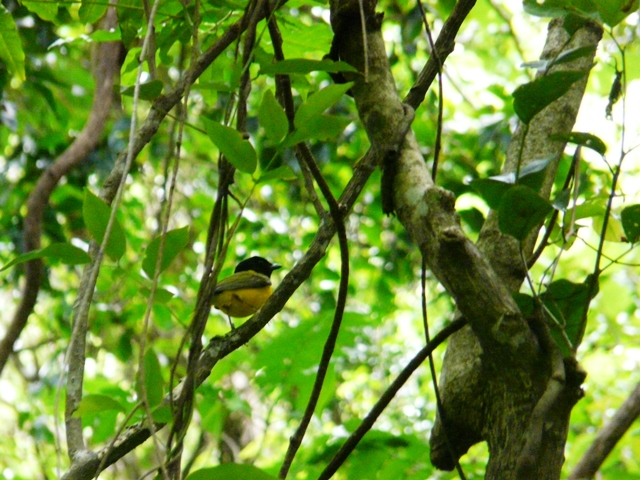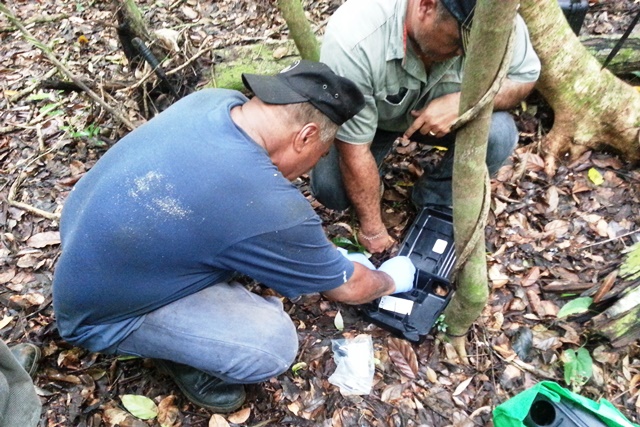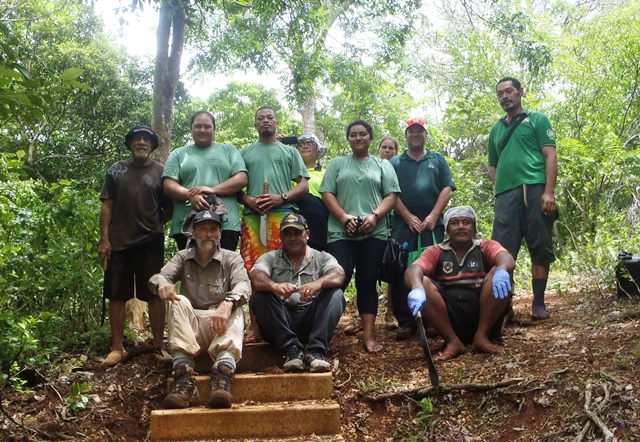
Biodiversity Conservation
The endemic Hengahenga, also known as the Tongan Whistler, and other native bird species have increased in population over the past year on Mt Talau in the Vava'u islands in the Kingdom of Tonga, with support from several projects executed by the Secretariat of the Pacific Regional Environment Programme (SPREP) in partnership with the Government of Tonga.
Collaboration between two projects Integrated Island Biodiversity (IIB) and Prevention, control and management of invasive alien species in the Pacific Islands (IAS) funded by the Global Environment Fund Pacific Alliance for Sustainability have helped bring about the positive changes in native bird population in Tonga.
 The Tongan Whistler
The Tongan Whistler
Recent bird surveys, despite being hampered by tropical cyclone Winston, confirmed that the ongoing control of rats on Mt. Talau has led to an increase in the number of Tongan whistler, Polynesian triller and Polynesian starling. Rats heavily impact the survival and productivity of the Tongan whistler because the birds build an open bowl nest that is easily accessed by rats.
The work compliments other activities focused on the protection of the Mt. Talau rare endemic plant Casearia buelowii, which has been protected from pigs over the past year with the construction of a pig-proof fence.
Both these endemic species were identified as priority species during Tonga's Biodiversity Rapid Assessment (BIORAP) completed under the IIB project.
 Refilling the rat bait in the lockable, tamper-resistant feeding stations
Refilling the rat bait in the lockable, tamper-resistant feeding stations
Mr. Viliami Hakoumotu GEFPAS IAS Coordinator for Tonga says "It is great to see that we are able to utilise techniques from New Zealand successfully in Vava'u to protect our rare birds and plants which are under threat from invasive species. This species of Tongan whistler is not found outside of the Vava'u Islands and the Casearia buelowii has such a beautiful flower but is only found on this one mountain."
"Whilst the first opportunities to manage invasive species are prevention through biosecurity followed by eradication, or complete removal of a species from an island these options are not always realistic," said Mr David Moverley, SPREP's Invasive Species Advisor.
"Many invasive species are already widespread in the Pacific and impacting on our biodiversity, including our protected natural areas. When this is the case there are still options to protect these species and ecosystems with a site-led or asset based approach such as the project on Mt. Talau," added Mr Moverley.
 The team working on the rat control programme in the Vava'u islands in the Kingdom of Tonga
The team working on the rat control programme in the Vava'u islands in the Kingdom of Tonga
Site or asset based invasive species management is a relatively new concept in the Pacific but there is much to be learned from other countries such as New Zealand. In 2015 a Polynesian NZ Restoration Study Tour introduced participants from American Samoa, Niue, Samoa, and Tonga to these techniques and concepts. Restoration projects are now in place in Samoa and Tonga.
The work carried out to help eradicate rats on the island of Vava'u is funded by the Global Environment Fund (GEF) and the implementing agency is the United Nations Environment Program (UNEP). The executing agency is SPREP and the Ministry of Meteorology, Energy, Information, Disasters Management, Climate Change and Communications of the Government (MEIDECC) of Tonga in association with the Vava'u Environmental Protection Agency and the local Mt. Talau community.
For more information, please contact Mr David Moverley at [email protected]
Collaboration between two projects Integrated Island Biodiversity (IIB) and Prevention, control and management of invasive alien species in the Pacific Islands (IAS) funded by the Global Environment Fund Pacific Alliance for Sustainability have helped bring about the positive changes in native bird population in Tonga.
 The Tongan Whistler
The Tongan WhistlerRecent bird surveys, despite being hampered by tropical cyclone Winston, confirmed that the ongoing control of rats on Mt. Talau has led to an increase in the number of Tongan whistler, Polynesian triller and Polynesian starling. Rats heavily impact the survival and productivity of the Tongan whistler because the birds build an open bowl nest that is easily accessed by rats.
The work compliments other activities focused on the protection of the Mt. Talau rare endemic plant Casearia buelowii, which has been protected from pigs over the past year with the construction of a pig-proof fence.
Both these endemic species were identified as priority species during Tonga's Biodiversity Rapid Assessment (BIORAP) completed under the IIB project.
 Refilling the rat bait in the lockable, tamper-resistant feeding stations
Refilling the rat bait in the lockable, tamper-resistant feeding stations"Whilst the first opportunities to manage invasive species are prevention through biosecurity followed by eradication, or complete removal of a species from an island these options are not always realistic," said Mr David Moverley, SPREP's Invasive Species Advisor.
"Many invasive species are already widespread in the Pacific and impacting on our biodiversity, including our protected natural areas. When this is the case there are still options to protect these species and ecosystems with a site-led or asset based approach such as the project on Mt. Talau," added Mr Moverley.
 The team working on the rat control programme in the Vava'u islands in the Kingdom of Tonga
The team working on the rat control programme in the Vava'u islands in the Kingdom of TongaSite or asset based invasive species management is a relatively new concept in the Pacific but there is much to be learned from other countries such as New Zealand. In 2015 a Polynesian NZ Restoration Study Tour introduced participants from American Samoa, Niue, Samoa, and Tonga to these techniques and concepts. Restoration projects are now in place in Samoa and Tonga.
The work carried out to help eradicate rats on the island of Vava'u is funded by the Global Environment Fund (GEF) and the implementing agency is the United Nations Environment Program (UNEP). The executing agency is SPREP and the Ministry of Meteorology, Energy, Information, Disasters Management, Climate Change and Communications of the Government (MEIDECC) of Tonga in association with the Vava'u Environmental Protection Agency and the local Mt. Talau community.
For more information, please contact Mr David Moverley at [email protected]